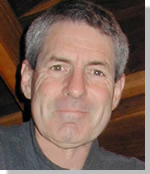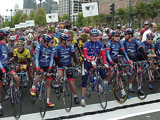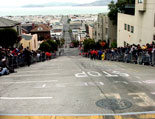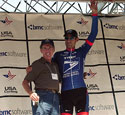 On The Road
On The Road
by: Bill Oetinger 10/1/2001
San Francisco Grand Prix
I'm assuming that if you're interested in cycling, you're probably already aware that there was a big bike race in San Francisco in early September called the San Francisco Grand Prix. If you're from the Bay Area, you may have attended the race, or, failing that, may have watched the race on local television. At the very least--if you were interested--you read the accounts of the race in the paper. So I'm not going to rehash the basic news story here. Instead, I want to talk about what it was like to be part of the crowd at this first-of-its-kind event in California.
 We had been anticipating this race for months, ever since it was first announced back in the spring. The assorted promos promised the participation of top line Euro-pro teams, in particular the US Postal Service team with their larger-than-life leader, Lance Armstrong. In the end, the European presence was not much more than token, except of course for the Posties, who were there in force. As the race was being promoted by the same folks who manage the US Postal team, this was hardly surprising. Chief competition came from the two marquee domestic squads, Mercury and Saturn, and the field was bulked out by all the other North American pro and top caliber amateur racers, plus that token smattering of Euro team members, if not precisely whole teams.
We had been anticipating this race for months, ever since it was first announced back in the spring. The assorted promos promised the participation of top line Euro-pro teams, in particular the US Postal Service team with their larger-than-life leader, Lance Armstrong. In the end, the European presence was not much more than token, except of course for the Posties, who were there in force. As the race was being promoted by the same folks who manage the US Postal team, this was hardly surprising. Chief competition came from the two marquee domestic squads, Mercury and Saturn, and the field was bulked out by all the other North American pro and top caliber amateur racers, plus that token smattering of Euro team members, if not precisely whole teams.
Anyway, if not exactly the Tour de France, it was as strong and as star-studded a field as we on the west coast have seen in a long while...at least since the last time the late, lamented Coors Classic came this way. (There was a time--in case you've forgotten or weren't around then to enjoy it--when the likes of Bernard Hinault, Laurent Fignon, Greg Lemond, et al raced on our very own backroads...ancient history, alas.) But now perhaps we had a chance to hope that maybe big-time racing had returned to the Bay Area, to California. The field looked good, the course was cool--all around picturesque and hilly San Francisco--and the promoters had been promoting like mad, whipping the local population into a froth of enthusiasm. The fact that Lance and his team had just polished off their third, victorious Tour de France only added fuel to the fire of publicity surrounding the event. It all seemed almost too good to be true, and we looked forward to the event with a mixture of excitement and skepticism.
Up here in Sonoma County, an hour north of the City, our club's e-mail chat list was buzzing with suggestions as to how to visit and view the race. Some folks carpooled right into the city. Some drove to the ferry terminals in Marin and boated to the Ferry Building in SF, smack dab on the start/finish line of the race course. Our little contingent elected to use our bikes to get around the course. We drove to Marin and rode across the Golden Gate Bridge into the Presidio and Pacific Heights. I was the only one in our gang who had bothered to figure out the geography of the course and where the fun viewing spots might be, so everyone else let me lead. My initial target was the top of the first big climb on Fillmore Street, one of the first spots we would ride to coming out of the Presidio. This was good in theory, but not so good in practice. We were lazy and didn't get out of bed early enough in the day to be on the scene in time to snag front row viewing spots on this prime time climb. By the time we got there, the crowd was ten deep all the way up the hill. No way could we see a thing. We pedaled around the block and came out on the course one block beyond the summit of the climb, where the riders would be catching their breath and beginning to roll into the long descent on Broadway. Here the crowds were thinner, and we managed to wiggle and weasle our way right up to the front row. We stayed here for a couple of laps (laps at this point being ten miles) and watched them as they emerged from the hell of the climb and spent our block in serious recovery.
Being right at the front allowed us to see the riders up close, and as they were going slowly in that catch-your-breath stretch after the climb, we got a really good look at them. I'm not one to go all goosey about celebrities and superstars, but I have to  admit to being quite thrilled to seeLance cruising by an arm's length away...someone I had only seen previously on TV, in the midst of all his epic accomplishments. At one time or another, I've chatted with Greg Lemond and Davis Phinney and a few other top level pros, and I've even ridden with a few moderately famous racers. But somehow Armstrong, in his current persona, really does stand head and shoulders above the rest...a colossus bestriding his world. Cynical and jaded as I try to be, I couldn't help but be impressed.
admit to being quite thrilled to seeLance cruising by an arm's length away...someone I had only seen previously on TV, in the midst of all his epic accomplishments. At one time or another, I've chatted with Greg Lemond and Davis Phinney and a few other top level pros, and I've even ridden with a few moderately famous racers. But somehow Armstrong, in his current persona, really does stand head and shoulders above the rest...a colossus bestriding his world. Cynical and jaded as I try to be, I couldn't help but be impressed.
But aside from seeing the riders up close for a few seconds, we weren't seeing much real action. So I convinced our gang to ride down the course to the other big climb on the circuit, Taylor Street, in hopes that we could find a better vantage point.
 The two big climbs each lap were the defining and deciding factors in this race, and to appreciate them, you need to understand that these are city streets...San Francisco streets. A typical rural hill will follow the natural contours of the landscape, beginning gradually, reaching its steepest pitch in the middle, and then rounding off over the brow of the hill. But a city hill climbs block by block, and each block is a precise, geometric bit of engineering, broken up by flat cross streets. Each block has its own gradient, and typically, they get steeper as they go up: 8%; 10%; 12%; etc. Fillmore was the longer of the two climbs, and ended with a long, brutal block of 18%. That's about the pitch where they start subsituting stairs for sidewalks. And remember, it doesn't ease off approaching the brow of the hill. It stays at its steepest, most quad-popping, lung-busting gradient right to the very end. That's why the riders looked so knackered as they came over the crest.
The two big climbs each lap were the defining and deciding factors in this race, and to appreciate them, you need to understand that these are city streets...San Francisco streets. A typical rural hill will follow the natural contours of the landscape, beginning gradually, reaching its steepest pitch in the middle, and then rounding off over the brow of the hill. But a city hill climbs block by block, and each block is a precise, geometric bit of engineering, broken up by flat cross streets. Each block has its own gradient, and typically, they get steeper as they go up: 8%; 10%; 12%; etc. Fillmore was the longer of the two climbs, and ended with a long, brutal block of 18%. That's about the pitch where they start subsituting stairs for sidewalks. And remember, it doesn't ease off approaching the brow of the hill. It stays at its steepest, most quad-popping, lung-busting gradient right to the very end. That's why the riders looked so knackered as they came over the crest.
The Taylor Street climb was not quite as long as Fillmor's and topped out with a block of "only" 16%. Actually there is a block of 18% or maybe even 20% after that, but the course turned left one block shy of the top, and that became the key to our enjoyment of the rest of the race. This final, steep block above the climb turned into a grandstand for spectators. We rode down the block to a spot just above the shoulder-to-shoulder spectators at curbside, and because the hill was so steep, we could see right over their heads and all the way down the length of the climb, several blocks long. It was like being in the upper deck at the ballpark. We lay our bikes down in the middle of the street, sat down on the sun-warmed pavement, and settled in for the rest of the race. As the race progressed, more and more people filled this block, until it was wall-to-wall crowd as well, but always with good visibility for everyone.
The organizers had come up with a clever plan for the course. First the riders did ten laps of a ten-mile loop, which included both the Fillmore climb and the Taylor climb. Then, after those 100 miles, they switched to a short cut across the loop that cut the distance to 5 miles per lap for five more laps, with only the Taylor Street climb left. That meant the riders did that climb 15 times, and five times in quick succession  as the race drew to its conclusion. I guess we got to that spot on about lap six, so we saw the racers struggle up the wickedly steep grade about eight or nine times, including, and most especially, the final time, when US Postal's George Hincapie attacked, literally sprinting up the final, 16% block to drop the two Saturn teammates, Trent Klasna and Michael Barry, who had been his breakaway companions for several laps.
as the race drew to its conclusion. I guess we got to that spot on about lap six, so we saw the racers struggle up the wickedly steep grade about eight or nine times, including, and most especially, the final time, when US Postal's George Hincapie attacked, literally sprinting up the final, 16% block to drop the two Saturn teammates, Trent Klasna and Michael Barry, who had been his breakaway companions for several laps.
Hincapie is not noted for being a great climber. His specialty is sprinting. So at first it seemed a bit odd to see him hanging in and eventually triumphing on these absurdly steep hills. But climbing these short, very steep pitches was in some ways more like contesting a finish line sprint--one brief, intense, all-out effort--as opposed to tapping out a tempo for 15 or 20 kilometers up an alpine pass.
 In case you didn't watch the race or read about it, you may be wondering: what happened to the all-conquering Armstrong? He did what all good team captains do: he rewarded his loyal lieutenant--Hincapie--for services rendered. Hincapie and his Postal teammates have pulled Armstrong through thousands of miles of Tour de France stages, setting him up for his big finishes. Now it was Armstrong's chance to return the favor. When Saturn attacked early and built a substantial lead over the main field, it was Armstrong who pulled Hincapie back to the leaders. Having done his job as a good domestique, Armstrong dropped back and eventually dropped out. He claimed to be a bit under the weather from a flu bug, but he needn't have apologized. He had done his job twice over...once as a team player and once as the famous drawing card the promoters needed to bring out those thousands of spectators. In both respects, he was very successful.
In case you didn't watch the race or read about it, you may be wondering: what happened to the all-conquering Armstrong? He did what all good team captains do: he rewarded his loyal lieutenant--Hincapie--for services rendered. Hincapie and his Postal teammates have pulled Armstrong through thousands of miles of Tour de France stages, setting him up for his big finishes. Now it was Armstrong's chance to return the favor. When Saturn attacked early and built a substantial lead over the main field, it was Armstrong who pulled Hincapie back to the leaders. Having done his job as a good domestique, Armstrong dropped back and eventually dropped out. He claimed to be a bit under the weather from a flu bug, but he needn't have apologized. He had done his job twice over...once as a team player and once as the famous drawing card the promoters needed to bring out those thousands of spectators. In both respects, he was very successful.
About those spectators...there surely were a lot of them! I've read estimates that range from 150,000 to 350,000. With folks coming and going and strung out all over the course, there's no way anyone could count the house with any accuracy. It was just a whole big bunch of people. If you watched the TV coverage of the race, you could see that in a few spots around the course, the crowds were quite thin, just as they might be out in the middle of nowhere on a Tour stage. But anywhere the course got interesting--at the start/finish, at any tricky corner, and especially on the two big climbs--then the crowd was immense. And it wasn't just immense, it was wild. We could actually hear the riders coming each lap even before we could see them, because they were preceded by a roaring, rolling wave of cheering. And when the riders would tackle the steepest blocks at the tops of the climbs--oh, how they struggled!--the fans would simply go berserk, urging them on, willing them up the walls with sheer enthusiasm and intensity.
Many of the domestic racers, who haven't competed in Europe, had never seen crowds like this. They were astounded by riding within this rolling canyon of cheering, lap after lap. They said it really did give them the boost they so desperately needed to grind up the brutal hills, especially in the later laps. The crowd cheered not only for the front-runners, but for every rider out there. They even cheered hugely for one San Francisco bike-mounted police officer, who chugged ever-so-slowly up the Taylor Street wall in a lull between the passing riders. Folks who have been part of the crowds at big Europrean races, said this was comparable, and the crowds were certainly as large and as boistrous as any I've seen on the big climb at the USPro Championship in Philadelphia.
On the final lap, everyone was keyed up to a fever pitch, and when Hincapie attacked, the cheering, which I had thought could not get any louder, went up several notches, to the hair-standing-on-end level of intensity. But as intense as this crowd was, it was also a really mellow crowd...cheerful and laid back and neighborly, at least until the riders came by. After having been in some rather sketchy mob scenes--Altamount, for instance--I've become a bit leery of the psychoses of big crowds. But these folks were pleasant all day long. I never felt any of that rabid, edgy energy that presages an ugly scene. Not everyone in the crowd was an obvious hard-core bikie. Lots of "normal" people appeared to have come out just to see what all the excitement was about, and then they got caught up in it and became part of the excitement. It was definitely a contagious rush of high spirits. And this wasn't just my subjective impression. Police and course marshalls reported no significant problems all day long, and that includes any hassles with the thousands of motorists who were forced to work around the closed roads and the teeming throngs.
After the last racers and follow vehicles straggled by, we rode down to a sidewalk cafe at the bottom of the hill. As we sat there on the corner, sipping coffee and nibbling our lunches, we could look back up the street, and it looked much more daunting from the bottom looking up than it did from the top looking down. (Have you ever noticed that a ski slope doesn't look too steep from the bottom, but when you get off the chairlift at the top and look down, it suddenly seems a whole lot steeper? Here, the perception was exactly the opposite.) To have climbed that thing 15 times at race pace, along with ten times on the longer, steeper Fillmore wall...well, it just seemed extremely cruel, and we tipped our hats to those hard boys who had conquered such a course.
Finally, full of lunch and satisfied with the spectacle we had witnessed--and been a part of--we pedaled back over the Golden Gate and did a few lazy, backroad loops in Marin to make us feel like we'd done some riding on the day. Those easy miles were a nice way to wind down after the crackling energy of the massive, manic crowd.
From what I've heard, everyone associated with the event is calling it an unqualified success. The City and da Mayor are happy. The police are cautiously pleased. The promoters are over the moon. The riders loved it, in spite of how hard the course was. And the hundreds of thousands of spectators couldn't have been more jazzed. So it's safe to predict that the event will be back next year, possibly bigger and better. There is even some talk of awarding UCI points, which would be sure to draw more of the big name European teams. We shall see. For now, we're just happy it was as good as it was, and that we were there to share in it.
Bill can be reached at srccride@sonic.net

